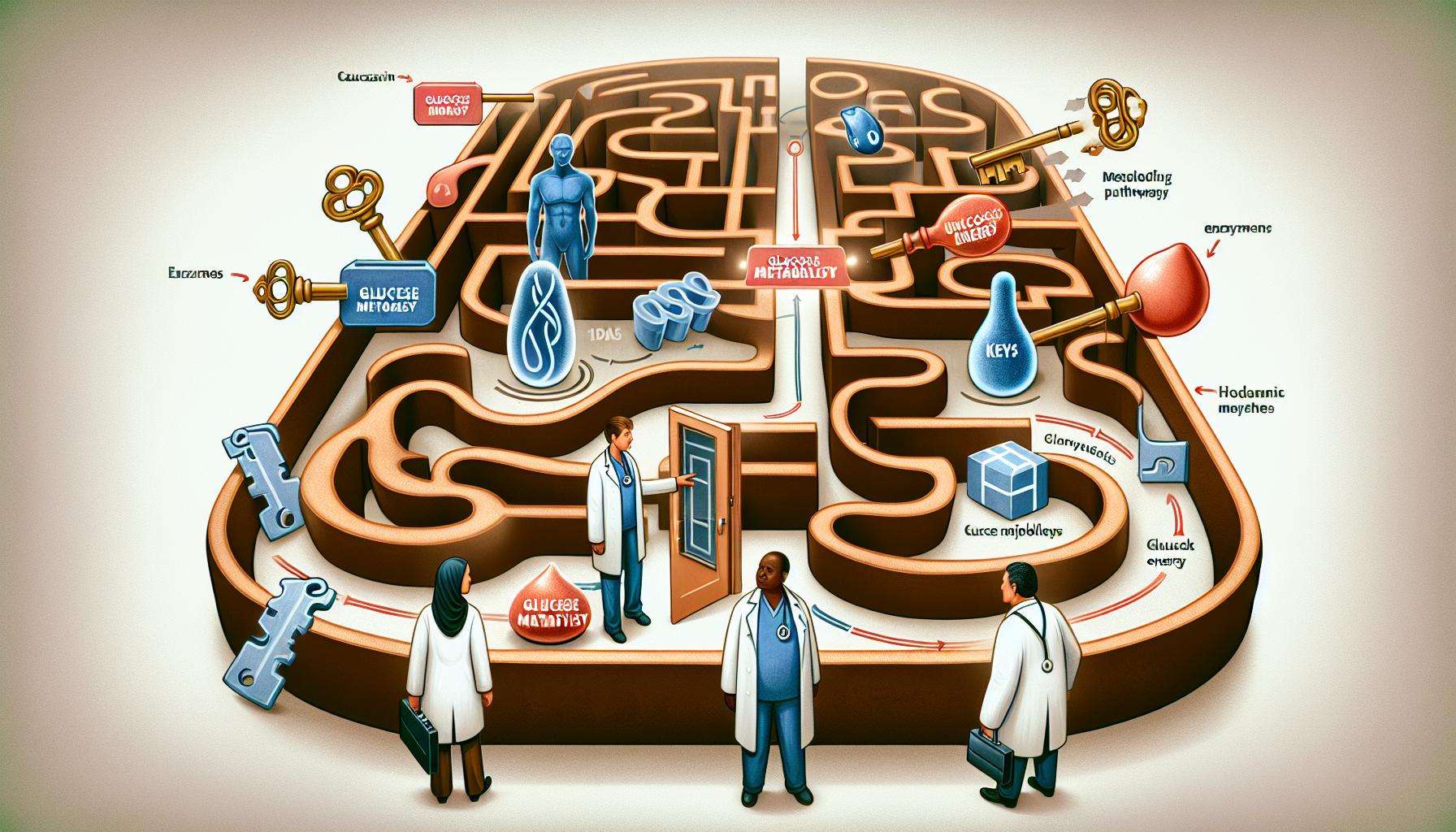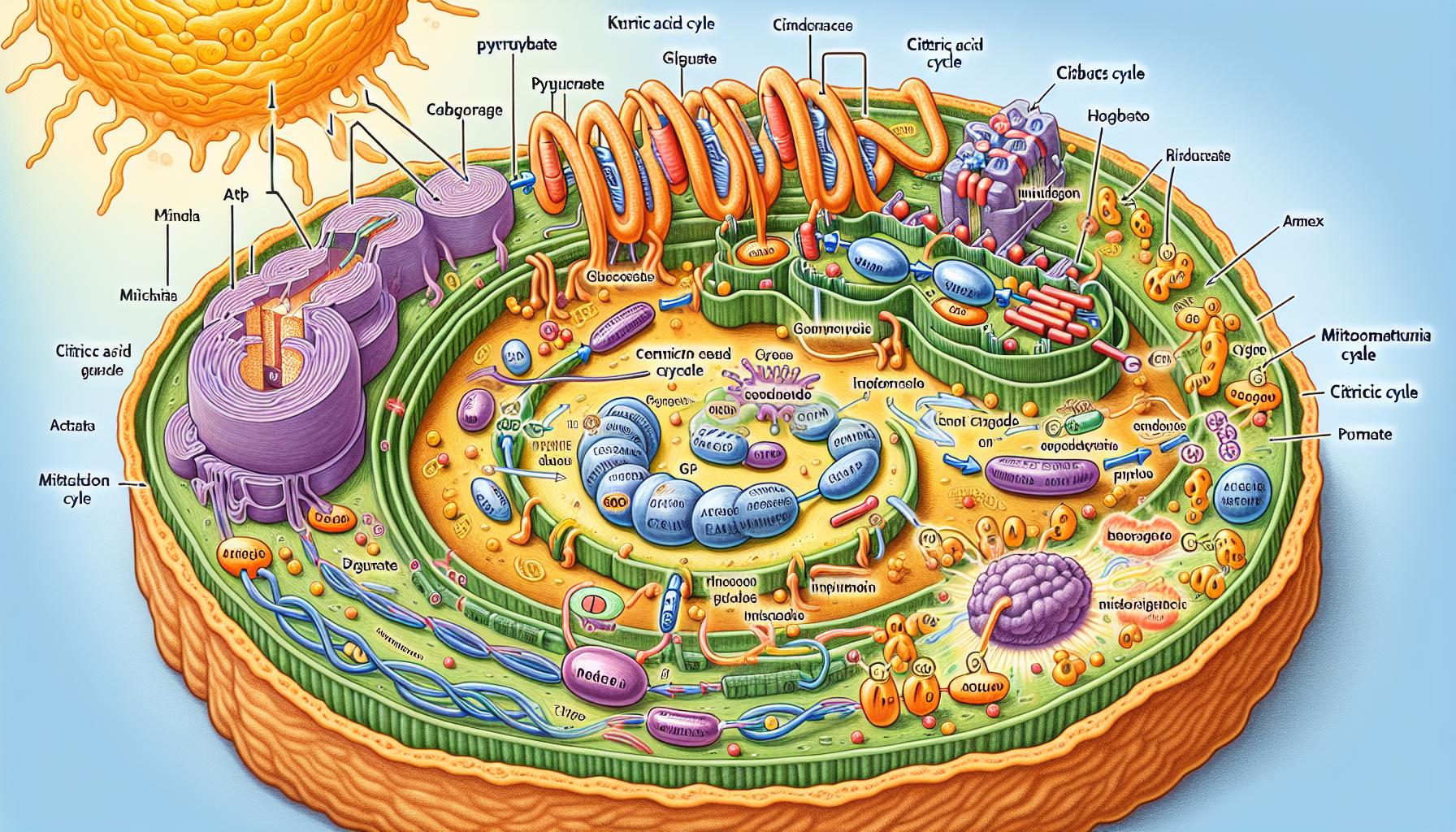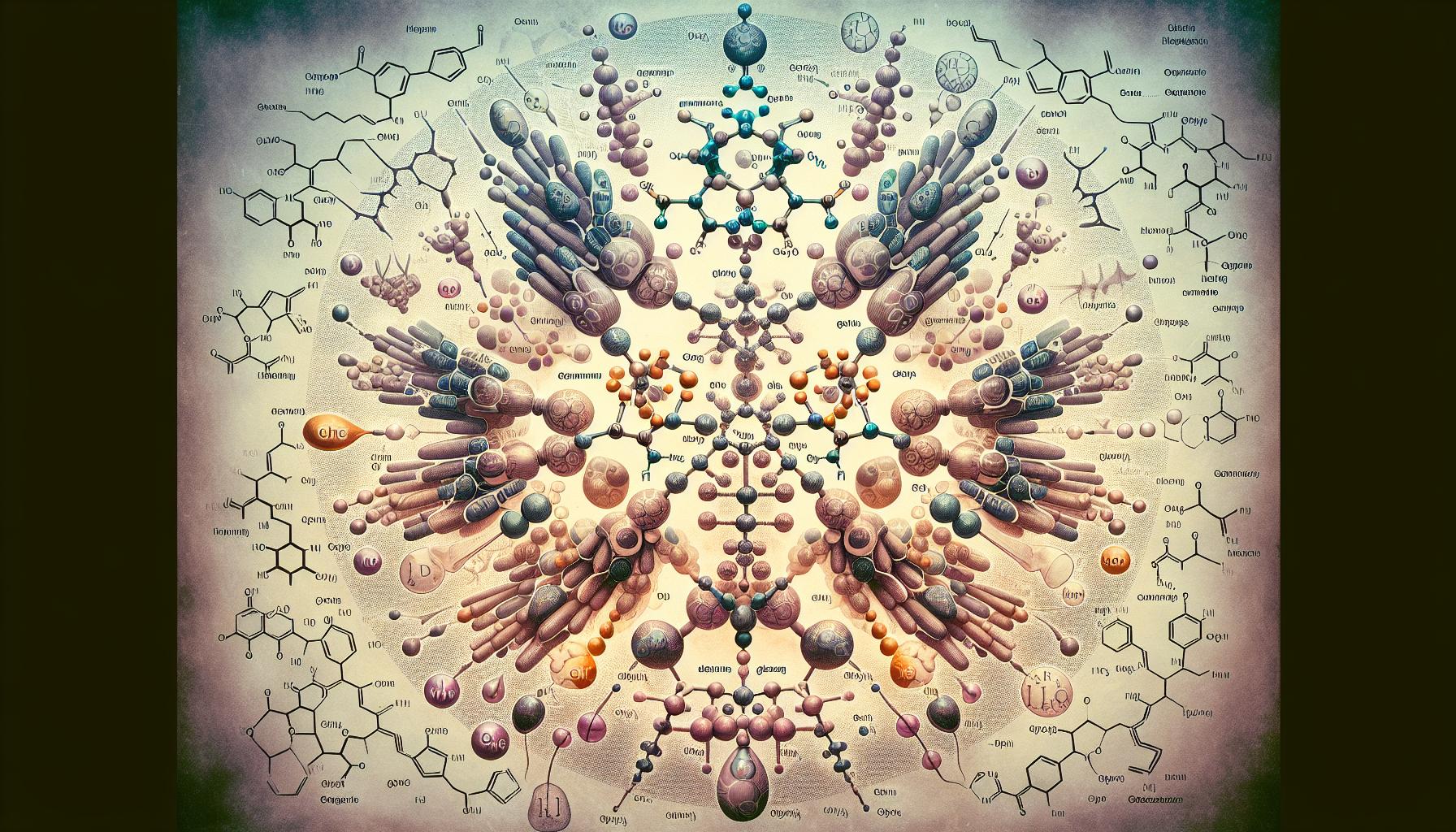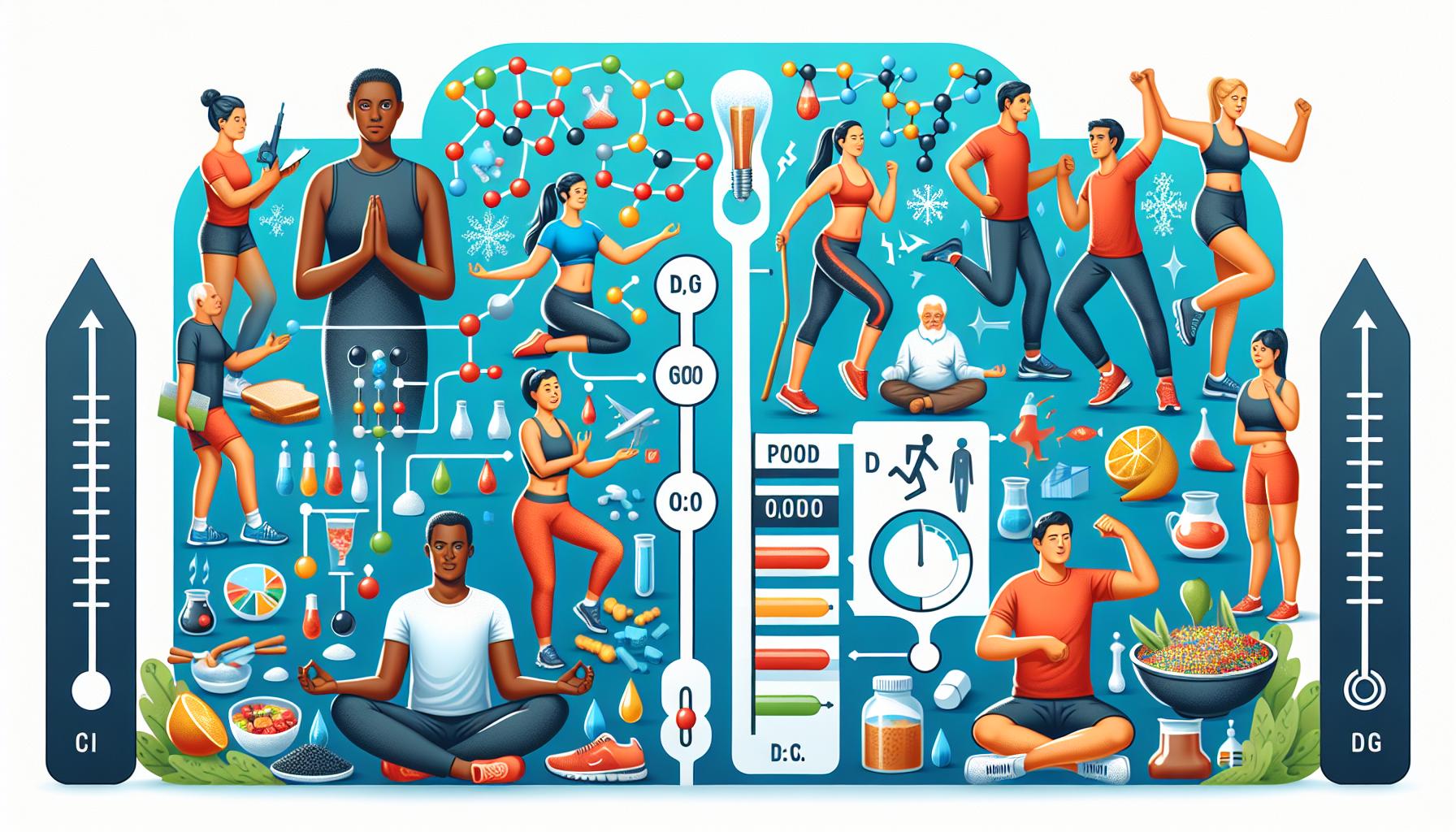Welcome to a thrilling exploration of a vital process that goes on tirelessly within our body, every moment of every day – Glucose Metabolism. It powers every thought we think, every move we make, and even our growth – the rhythm of our life. Follow us as we unlock the secrets of this fascinating journey of glucose, power-packed in the food we gulp down, coursing through our bloodstream, finally being transformed into the vital energy we need to survive. Our post is a guided tour to the mitochondrial powerhouse and the metabolic dance floor where glucose, insulin, and glucagon waltz to the tune of life. Read on, and you will discover the little-known stories behind the hormones that regulate our glucose metabolism, and how our lifestyle choices impact this intricate dance. This is a glimpse into life’s engine room, welcome to the real-life guide to “Unlocking Vitality: A Deep Dive into Glucose Metabolism Mastery.

Table of Contents
- Understanding the Glucose Metabolism Journey: From the Food We Eat to Cellular Energy
- The Role of Glycolysis, Mitochondria and the Krebs Cycle in Energy Production
- Insulin and Glucagon: The Key Hormones Governing Glucose Metabolism
- Lifestyle Choices: Their Impact on Glucose Metabolism and Recommendations for Optimal Health.
- Q&A
- To Conclude
Understanding the Glucose Metabolism Journey: From the Food We Eat to Cellular Energy

When we eat, our body takes the glucose, a simple sugar from the food and commences a sensational journey, akin to an intricate dance where every step is crucial. This journey, also known as glucose metabolism, is the lifeline that powers our every action - our movements, our thoughts, even our growth. This elaborate process grants cells the vitality they need to survive, and keep us alive and kicking.
Glycolysis is where this journey starts. Each glucose molecule is split into two molecules of pyruvate in the cell’s cytoplasm, providing a rapid, albeit minor burst of energy. Upon this, the pyruvate heads to the mitochondria, the cell’s powerhouse. It is here that pyruvate transformations occur - it morphs into a new molecule called Acetyl CoA, lighting the wick for the Krebs cycle. The continuous spinning of this cycle leads to the creation of energy-packed molecules like NADH and FADH2. Subsequently, these molecules take part in the electron transport chain, a virtual power plant at a molecular level, that manufactures ATP, the energy currency of every cell.
The meticulous regulation of this energy production falls on two crucial hormones, insulin and glucagon. Imagine them as gatekeepers of glucose metabolism, ensuring the ideal amount of glucose is readily available at the right time. Insulin acts as a key, it unlocks the cell doors, permitting glucose to enter and be used for energy. When one has eaten and the glucose levels rise, insulin is released to lower this, ushering glucose into the cells. On the contrary, in situations where glucose levels fall too low, glucagon steps in. It signals the liver to transform the stored glycogen into glucose, effectively raising the blood glucose levels. Regardless of us eating or being in between meals, this delicate dance between insulin and glucagon is perpetual. They maintain the balance our bodies need to function effectively.
Your lifestyle choices have a significant impact on glucose metabolism. Every meal you consume, every physical activity you engage in, and even the rest you take, all play vital roles in dictating how your body processes glucose. Striking the right balance with wholesome diet and appropriate life choices is the key to maintaining optimal glucose metabolism.
The Role of Glycolysis, Mitochondria and the Krebs Cycle in Energy Production

In every single cell of our bodies, an intricate process called Glucose Metabolism is constantly at work. This clever dance begins with Glycolysis, a process in the cell’s cytoplasm where each glucose molecule is split into two molecules of Pyruvate. This initial procedure yields a modest but quick energy infusion that acts as the start point for more complex energy production stages.
The next authority in this energy generation process is the cell’s powerhouse – the Mitochondria. This is where pyruvate is metamorphosized into a molecule known as Acetyl-CoA, thus setting the stage for the Krebs Cycle. Acting like a power generator rotating incessantly, this cycle produces energy-packed molecules such as NADH and FADH2. Such molecules then journey into the Electron Transport Chain – sort of a microscopic power station – where ATP, the cellular energy currency, is generated.
The facilitation of this energy production is regulated by two pivotal hormones – Insulin and Glucagon. These hormones act as guardians of glucose metabolism, ensuring optimal glucose availability for our bodies at any given time. Insulin, produced by the pancreas, is akin to a key that unlocks the door of our cells, permitting glucose to enter and get converted into energy. Meanwhile, when glucose levels fall excessively low, Glucagon intervenes by signaling the liver to transform stored glycogen into glucose, thereby effectively raising blood glucose levels.
It’s important to also point out that our lifestyle choices play a vital role in glucose metabolism. The food we consume, the exercise routines we engage in and the rest we take all have a significant impact on how our bodies process glucose. The right balance can ensure our bodies function optimally.
Insulin and Glucagon: The Key Hormones Governing Glucose Metabolism

The Vital Role of Insulin and Glucagon
Among the crucial players of glucose metabolism, the hormones Insulin and Glucagon hold a distinctive position. Insulin is produced by the pancreas and acts as a critical key that opens the door to our cells, enabling glucose to penetrate and be utilized for energy. This is particularly important after a meal when glucose levels in our bloodstream escalate. The release of insulin assists in cheapering these levels by funneling glucose into the cells.
Meanwhile, its partner Glucagon takes center stage when glucose levels plunge too low. In such instances, the hormone signals the liver to decompose stored glycogen into glucose, effectively elevating blood glucose levels. This intricate interplay between insulin and glucagon carries on continuously, ensuring that our cells always have access to the energy they need, whether we’ve just eaten or are between meals.
Balance and the Role of Lifestyle Choices
Together, Insulin and Glucagon maintain the equilibrium our bodies require for optimal function. However, our lifestyle choices critically influence glucose metabolism. The food we ingest, the workouts we partake in, and even the rest we engage all contribute significantly to the way our bodies handle glucose.
- A well-balanced diet rich in whole foods
- Regular exercise
- Salary amounts of rest
Paying heed to these elements creates a harmonious environment for these key hormones to function at their best, ensuring a smooth and efficient process of glucose metabolism.
Lifestyle Choices: Their Impact on Glucose Metabolism and Recommendations for Optimal Health

The life-sustaining voyage of glucose, a simple carbohydrate derived from our cuisine, all starts with glycolysis, an event that fractures each glucose molecule into a duo of pyruvate molecules. This cycle unravels within the cell’s cytoplasm, sparking a minor yet swift burst of energy. The adventure for pyruvate does not end here but continues to the cell’s powerhouse – the mitochondria, transforming it into a molecule, Acetyl CoA. This transformation triggers the subsequent stage, the Kreb cycle, a practical energy munitions mill, churning out energy-rich molecules like NADH and FADH2.
These molecules move on to the Electron Transport Chain, the cellular equivalent of a powerhouse generating ATP, the vital currency of cellular energy. Orchestrating this energy generation dance are two essential hormones: insulin and glucagon. These hormones act as the glucose metabolism gatekeepers, assuring our bodies are granted just the right amount of glucose needed at any given time. Our lifestyle choices, notably diet, exercise, and rest significantly dictate how our bodies process glucose. A well-balanced diet rich in whole foods has a direct impact on an optimal glucose metabolism pathway.
| Hormone | Function |
|---|---|
| Insulin | Acts as a key to allow glucose entry into cells |
| Glucagon | Signals the liver to convert stored glycogen into glucose, effectively raising blood glucose levels. |
Frequently Asked Question – Q/A
Q: What is glucose metabolism?
A: Glucose metabolism is the process through which glucose, a simple sugar from our food, travels through our bloodstream and into our cells where it is converted into energy. This is a constant and crucial process that powers every cell in our bodies.
Q: How does the process of glucose metabolism unfold?
A: Glucose metabolism starts with a process called glycolysis, where each molecule of glucose is broken down into two molecules of pyruvate in the cytoplasm of the cell. Then, the pyruvate is transferred to the mitochondria, converted into a molecule called acetyl COA, and moves onto the Kreb cycle which produces energy-rich molecules. These molecules go through the electron transport chain, generating ATP – the energy currency of the cell.
Q: What are the key hormones that regulate glucose metabolism?
A: Insulin and glucagon are two key hormones that regulate glucose metabolism. Insulin, produced by the pancreas, enables glucose to enter cells and be used for energy. It is mainly released when we’ve had a meal and glucose levels in the blood rise. On the other hand, when glucose levels dip too low, glucagon signals the liver to convert stored glycogen into glucose, effectively raising blood glucose levels.
Q: How do lifestyle choices affect glucose metabolism?
A: Our lifestyle choices, including the food we eat, the physical activity we engage in, and even the amount of rest we get, greatly impact our glucose metabolism. Consuming a well-balanced diet rich in whole foods, exercising regularly, and getting plenty of rest can enhance the way our bodies process glucose.
Q: What role does insulin play in glucose metabolism?
A: Insulin acts like a key to our cells, allowing glucose to enter and be used for energy. It also helps to lower blood glucose levels by ushering glucose into the cells once those levels rise after meals.
Q: How does glucagon respond when glucose levels are low?
A: If glucose levels dip too low, glucagon steps in. This hormone signals the liver to break down stored glycogen into glucose, leading to increased blood glucose levels.
Q: Why is glucose metabolism so essential to our survival?
A: Glucose metabolism fuels every cell in our bodies. It powers our movements, thoughts, and growth. Without it, our bodies wouldn’t have the necessary energy to function.
To Conclude
And there we have it – a whirlwind tour deep within the unique world of glucose metabolism, that ever-essential process that allows us to do everything from thinking to moving and growing. From the intricate unfolding of glycolysis in the cytosol, to the impressive energy production happening within the mighty mitochondria, we’ve seen the scientific ballet choreographed by glucose, pyruvate, acetal COA, and ATP.
The gatekeepers of this process – insulin and glucagon – have proved critical in maintaining the balance and rhythm that our bodies require. Indeed, it’s worth bearing in mind just how big an impact our lifestyle choices can have on this process. The food you eat, the physical activity you engage in, and even the rest you take can all profoundly affect the efficiency and effectiveness of glucose metabolism.
Remember, energy is currency in the infinitely bustling, busy world of our cells. Choose wisely when investing. After all, in the grand scheme of things, these tiny transactions are what keep us alive. Until our next scientific journey, stay curious, make smart choices, and keep unlocking your vitality, one glucose molecule at a time.






